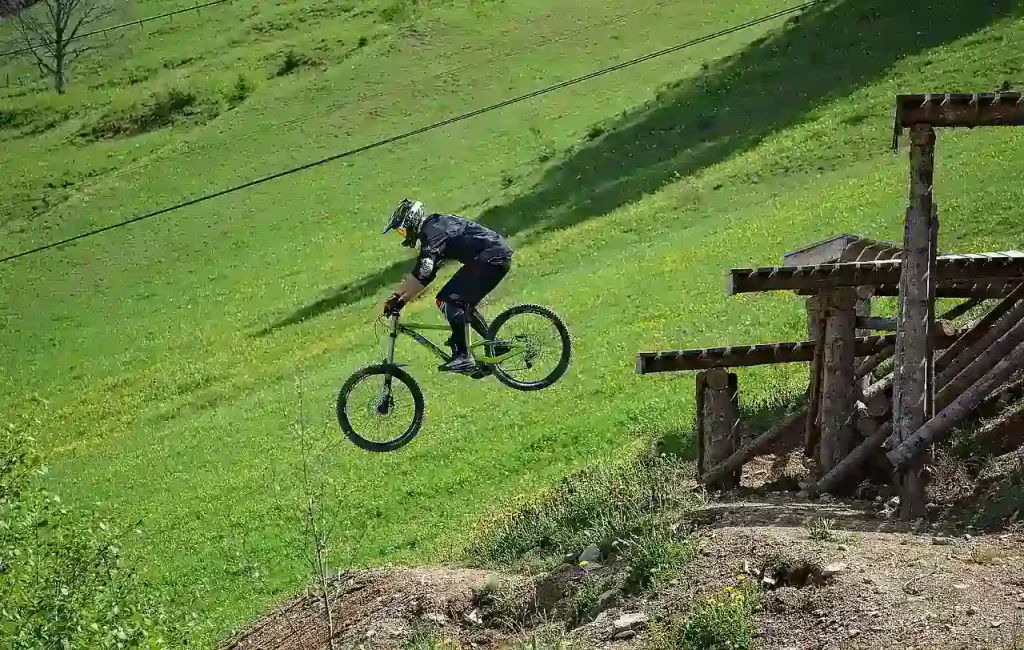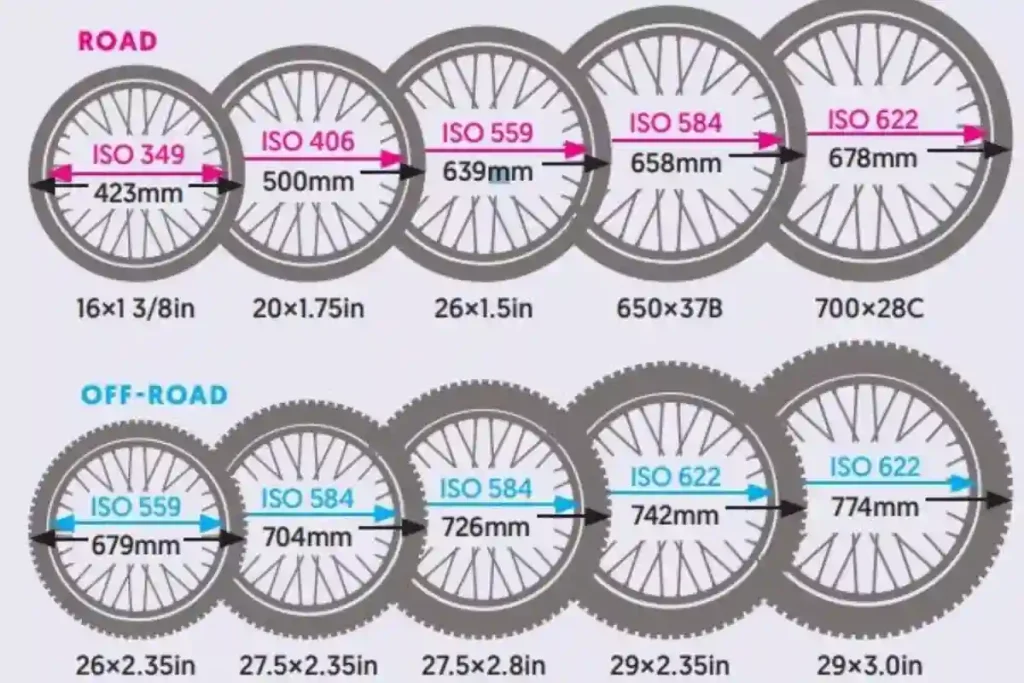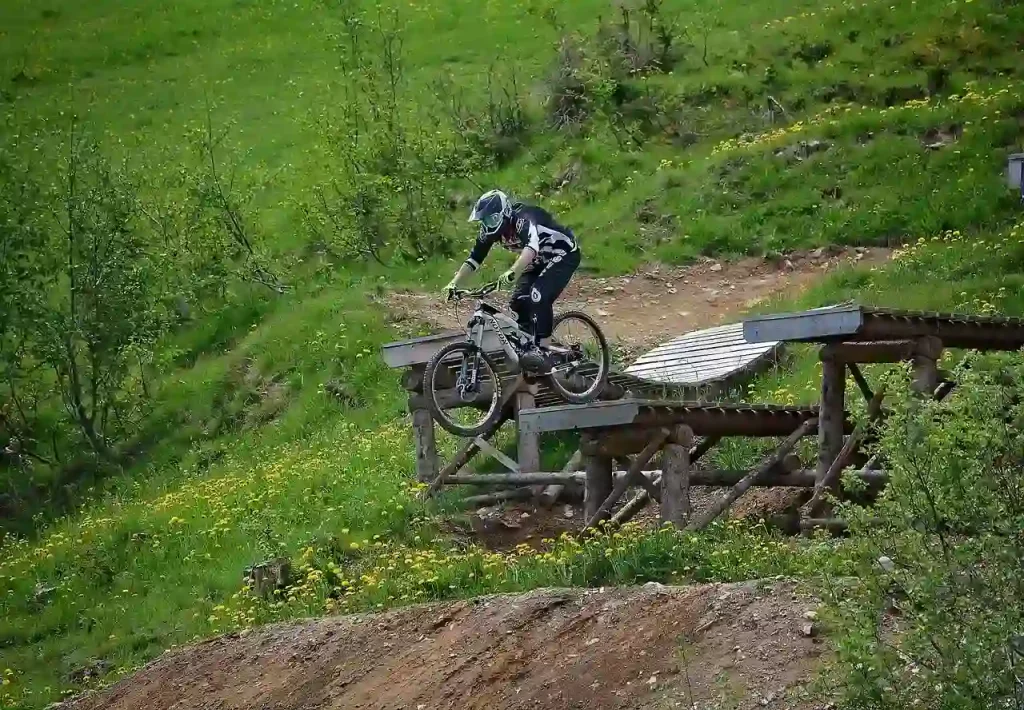Downhill bikes are designed for high-speed descents on steep and rough terrain, prioritizing stability and control over agility.
While they can handle some jumps, they aren’t optimal for jumping due to their heavy frame, long wheelbase, and suspension setup, which might hinder agility and maneuverability on jumps and pump tracks.
For dedicated jumping, bikes like dirt jump bikes are more suitable due to their lighter build, shorter wheelbase, and stiffer suspension, allowing better control and agility in the air. Riders seeking bikes specifically for jumping or pump tracks tend to prefer lighter, more agile options than downhill bikes.
Downhill Bikes and Jumping: Can They Handle Jumps?
Downhill biking, with its thrill-seeking descents and rugged trails, often raises a critical question among riders: Can downhill bikes effectively handle jumps?
For beginners eager to explore this facet of biking, understanding the dynamics between downhill bikes and their prowess in jumps is crucial.
Safety Considerations: Jumping with Downhill Bikes
When it comes to jumping on a downhill bike, safety reigns supreme. For those new to the exhilarating world of jumps, prioritizing protective gear is paramount.
Investing in helmets, body armor, and sturdy gloves significantly minimizes the risk of injury.
These bikes boast robust frames and advanced suspension systems, mitigating impact forces and enhancing safety.
Inspecting jump sites beforehand allows riders to gauge angles and landing zones, promoting safer jumps. Learning proper jumping techniques, such as manipulating body weight and controlling the bike mid-air, aids in executing safer landings and reducing injury risks.
Performance of Downhill Bikes in Jumping Situations

Downhill bikes, purpose-built for technical terrain and steep descents, exhibit commendable resilience when confronted with jumps.
Their durable construction and efficient suspension systems enable them to absorb shocks adeptly, ensuring a smoother landing experience.
However, while downhill bikes excel in descending prowess, their agility in mid-air maneuvers might slightly differ from specialized dirt jump bikes.
Despite this, with adequate handling and rider expertise, downhill bikes perform admirably across various jump sizes and complexities.
For riders venturing into the world of jumps, downhill bikes offer an exciting avenue.
But remember, caution, skill, and appropriate safety measures are crucial for a fulfilling and safe jumping experience
Choosing Between Downhill Bikes and Other Types of Jumps
Understanding the distinct purposes of downhill bikes and specialized jump bikes is crucial for comparing and tackling jumps.
Downhill bikes, tailored for aggressive descents, excel at managing steep terrain and formidable obstacles. However, their performance in aerial maneuvers might differ from bikes specifically engineered for dirt jumps or pump tracks, emphasizing agility and nimbleness mid-air.
Consider your riding style and the type of jumps you aim to conquer.
If conquering challenging descents excites you, a downhill bike offers stability and durability. Conversely, for riders seeking intricate aerial maneuvers, dedicated jump bikes might provide enhanced maneuverability and agility.
Wheel Size Impact on Downhill Bikes’ Jumping Abilities

Debates persist regarding the impact of wheel size on downhill bikes’ jumping abilities.
Larger wheels could potentially generate more centrifugal force, making mid-flight adjustments challenging. Some argue that smaller wheels offer increased agility, enabling quicker responses in the air.
However, the wheel size debate isn’t conclusive and may vary based on individual preferences and riding styles.
Riders should experiment with different wheel sizes to determine their comfort and performance for jumping.
Key Features that Affect Downhill Bikes’ Jumping Potential
Several pivotal features significantly influence a downhill bike’s jumping capabilities. Robust frame construction, efficient suspension systems, and geometry designed for stability play crucial roles.
These bikes boast durable components built to endure high-impact landings and absorb shocks from jumps and rough terrain.
Additionally, a bike’s agility and handling, stemming from its geometry and suspension setup, impact its ability to navigate jumps effectively.
The optimal jumping potential is often found in bikes with sturdy builds, advanced suspension, and geometry that balances stability and agility.
Assessing Downhill Bikes’ Suitability for Jumping Trails

Assessing a downhill bike’s suitability for jumping trails involves understanding its primary design and capabilities.
These bikes excel at conquering steep descents and navigating rough terrain. However, their suitability for specific jumping trails varies.
While their robust frames and advanced suspensions handle shocks and rough landings effectively, their overall agility for intricate aerial maneuvers on jump-oriented trails might be slightly limited compared to specialized jump bikes.
Riders aiming for precision and agility might prefer dedicated jump bikes, while those seeking stability and durability for challenging descents find downhill bikes more suitable.
Ultimately, choosing the right bike depends on the rider’s preferences, riding style, and the nature of the trails they wish to conquer.
Understanding Suspension and Its Role in Downhill Bike Jumps
Suspension systems significantly impact a downhill bike’s performance on jumps.
These bikes typically feature dual-suspension setups, adept at absorbing impact from jumps and providing a smoother landing.
Tunable suspension settings allow riders to adjust and optimize their bike’s response to different trail conditions and jump sizes.
Well-tuned suspension enhances traction, control, and comfort during jumps, reducing the impact on the rider’s body and enabling confident execution of jumps.
Geometry’s Impact on Downhill Bikes for Jumping
The geometry of a downhill bike crucially influences its behavior during jumps. Downhill-specific geometries, characterized by longer wheelbases, slacker head angles, and lower bottom brackets, prioritize stability and confidence during descents and jumps.
While these design elements enhance stability, they may slightly compromise agility and maneuverability in scenarios requiring precise aerial maneuvers.
Riders must consider how specific geometries affect their riding preferences and the types of jumps they aim to conquer.
Balancing stability and agility based on individual riding styles becomes essential when choosing a downhill bike for jumping.
Read more: Can Downhill Bikes Go Uphill?
Pedals and Their Influence on Downhill Bikes’ Jumping Performance
Pedals are pivotal components influencing a downhill bike’s jumping performance.
Flat pedals offer a connected feel, allowing riders to adjust foot positions and execute precise movements during jumps.
On the contrary, clipless pedals provide a secure attachment, minimizing the risk of feet slipping off during jumps.
Riders often choose pedals based on personal preferences and riding styles, considering factors such as foot stability, maneuverability, and the level of connection they seek with the bike during jumps.
Dirt jump bikes or slopestyle bikes are typically best for jumping due to their specific design for aerial maneuvers, durability, and maneuverability.
Are mountain bikes meant for jumping?
Mountain bikes can handle jumps, but specific types like dirt jump bikes or slopestyle bikes are better suited for jumping due to their specialized construction for stunts and aerial maneuvers. Regular mountain bikes might not be as optimized for jumping.
What bikes are best for stunts?
Bikes designed explicitly for stunts and aerial maneuvers, like dirt jump bikes or slopestyle bikes, are ideal for performing stunts due to their robust build, shorter wheelbases, and maneuverability.
How do you jump higher on a mountain bike?
To jump higher, focus on your technique, including compressing the suspension before the lip of the jump, explosive leg extension, pulling the bike upwards, and tucking in the bike and body in the air. Proper timing and body positioning also play crucial roles in achieving greater height.
What’s more dangerous, jumping or going downhill?
Downhill biking statistically poses more risk of serious injury compared to jumping due to the overall higher risk in downhill biking, where speed and rough terrain contribute to accidents and injuries.
How well do DH bikes jump?
Downhill (DH) bikes are designed more for speed and stability in downhill racing than jumps. While they can handle jumps, their design prioritizes stability at high speeds and rough terrains, so they might not be as nimble or optimized for aerial maneuvers as dirt jump bikes or slopestyle bikes.

